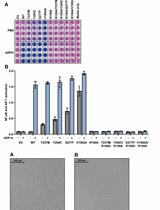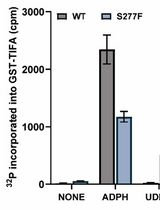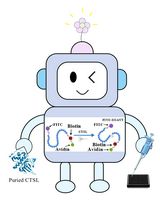- EN - English
- CN - 中文
Assessment of Oxidative Stress Biomarkers in Rat Blood
大鼠血液中氧化应激生物标志物的评估
发布: 2023年03月05日第13卷第5期 DOI: 10.21769/BioProtoc.4626 浏览次数: 2480
评审: Vivien Jane Coulson-ThomasSudhir VermaXiao Lin
Abstract
Redox status assessments are time-consuming, require a large volume of samples and great reagent amounts, and are not adequately described for methodological reproducibility. Here, the objective was to standardize redox balance determination, based on previously described spectrophotometric tests in pregnant rats, to improve precision, time dispensed, and the volume of samples and reagents, while maintaining accuracy and adequate cost benefits. This protocol summarizes oxidative stress markers, which focus on spectrophotometric tests for the assessment of thiobarbituric acid–reactive substances, reduced thiol groups, and hydrogen peroxide, as well as the antioxidant activity of superoxide dismutase, glutathione peroxidase, and catalase in washed erythrocyte and serum samples from full-term pregnant rats. For non-pregnant rats and other species, it is necessary to standardize these determinations, especially the sample volume. All measurements were normalized by the estimated protein concentrations in each sample. To establish optimum conditions for the reproducibility of the proposed methods, we describe all changes made in each assay’s steps based on the reference method reassessed for the new standardizations. Furthermore, the calculations of the concentrations or activities of each marker are presented. Thus, we demonstrate that the analysis of serum samples is easier and faster, but it is impossible to detect catalase activity. Furthermore, the proposed methods can be applied for redox balance determination, especially using smaller reagent amounts and lower sample volumes in lesser time without losing accuracy, as is required in obtaining samples during rat pregnancy.
Keywords: Oxidative stress (氧化应激)Background
Reactive oxygen species (ROS) are free radicals; their non-radical intermediates, produced in a limited amount in response to physiological stimuli, mediate inter- and intracellular signaling (Fujii et al., 2005). Hydroxyl radicals are free radicals that are capable of causing lipid peroxidation in the plasma membrane or in organelles that contain large quantities of polyunsaturated fatty acid side chains (Burton and Jauniaux, 2011). Lipid peroxidation is mostly assessed by measuring thiobarbituric acid–reactive substance (TBARS) concentration (De Souza et al., 2010). Furthermore, amino acids are also a target for oxidative damage. The extraction of hydrogen ions from the thiol group of cysteine can form disulfide bonds and abnormal protein folding, which can lead to functional impairment and protein aggregation (Burton and Jauniaux, 2011). To assess reduced thiol concentrations, the determination of the content of reduced sulfhydryl groups (-SH) provides useful and early indications of antioxidant capacity and structural and functional alterations in the cell membrane (Kumar and Maurya, 2013).
Another oxygen-free radical is the superoxide anion (O2-), which is mainly generated by mitochondria and the endoplasmic reticulum (Burton and Jauniaux, 2011). The superoxide anion is detoxified by superoxide dismutase (SOD) enzymes, which convert O2- to hydrogen peroxide (H2O2). Hydrogen peroxide is not a free radical, making it less reactive than the superoxide anion. However, it comes under the term ROS as it is intimately involved in the generation and detoxification of free radicals. H2O2is, in turn, detoxified to water by the enzymes catalase (CAT) and glutathione peroxidase (GSH-Px) (Burton and Jauniaux, 2011). An imbalance between ROS production and antioxidant defenses causes oxidative stress, which might damage macromolecular classes (lipids, protein, and DNA), leading to loss of function and even cell death (Burton and Jauniaux, 2011; Birben et al., 2012).
The redox status is an important measurement to evaluate pathophysiological mechanisms involved in several disorders in pregnancy (Agarwal et al., 2005 and 2012). Several methods to assess redox status in reproductive processes have been reported, but the type of sample and techniques employed for oxidative stress measurement have yielded conflicting results that hinder comparisons. Most of these studies have measured total antioxidant capacity (TAC) (Pisoschi and Negulescu, 2012). However, the measurement of single components or TAC alone may not be a reliable indicator of oxidative stress under physiological and pathological conditions. Investigating the scavenging activity of antioxidant enzymes such as SOD, GSH-Px, and CAT might be very useful, as the target oxygen radicals of each of these enzymes would be known. Techniques such as spectrophotometry, fluorimetry, and high-performance liquid chromatography have been used for assessing oxidative stress and require a large sample volume and great reagent amounts, along with being very time-consuming (Wang and Joseph, 1999; Del Rio et al., 2005; Ćebović et al., 2013). Spectrophotometry, however, seems to be the most easily available and cost-effective technique.
Other studies must be performed to develop more accurate and low-cost techniques that are relevant for oxidative stress evaluation. Furthermore, investigators need blood samples for the determination of different biomarkers during pregnancy in rats. However, there are many methodologies that use a large volume for each marker, making it difficult to determine the different biomarkers in the same animal. Therefore, our objective was to standardize the redox balance determination based on previously described spectrophotometric tests in pregnant Wistar/Sprague-Dawley rats, to improve precision, time dispensed, and the volume of samples and reagents concentrations, while maintaining accuracy and adequate cost-benefits. Additionally, sample collection and processing steps are described in detail to provide reproducibility.
Materials and Reagents
Paper towel (Garden®, catalog number: 6610)
50 × 50 cm filter paper (Qualy®, catalog number: 1282)
Laboratory film (Parafilm®, catalog number: PM-996)
1.5 mL microtube (Eppendorf®, catalog number: 0030120086)
2.0 mL microtube (Eppendorf®, catalog number: 0030120094)
0.1–10 μL tip (Eppendorf®, catalog number: 0030000838)
2–200 μL tip (Eppendorf®, catalog number: 0030000889)
50–1,000 μL tip (Eppendorf®, catalog number: 0030000927)
96-well microplate (Corning®, catalog number: 3595)
Quartz cuvettes (Daigger Scientific®, catalog number: EF22153L/FX22153L)
10 mL volumetric flask (ISO: 3819, Laborglas®, catalog number: 9110608)
50 mL volumetric flask (ISO: 3819, Laborglas®, catalog number: 9110617)
100 mL volumetric flask (ISO: 3819, Laborglas®, catalog number: 9110624)
250 mL volumetric flask (ISO: 3819, Laborglas®, catalog number: 9110636)
600 mL volumetric flask (ISO: 3819, Laborglas®, catalog number: 9110648)
1,000 mL volumetric flask (ISO: 3819, Laborglas®, catalog number: 910654)
10 mL beaker (ISO: 4788, Laborglas®, catalog number: 9139608)
100 mL beaker (ISO: 4788, Laborglas®, catalog number: 9139624)
250 mL beaker (ISO: 4788, Laborglas®, catalog number: 9139636)
500 mL beaker (ISO: 4788, Laborglas®, catalog number: 9139744)
1,000 mL beaker (ISO: 4788, Laborglas®, catalog number: 9139754)
Glass sticker (Laborglas®, catalog number: 9108805)
1,000 mL Amber bottle (Laborglas®, catalog number: 91806545)
Purified water
2-mercaptoethanol (purity ≥99%) (Sigma-Aldrich®, catalog number: 8057400250)
2-thiobarbituric acid (TBA, purity ≥98%) (Sigma-Aldrich®, catalog number: T5500)
5,5-dithiobis (2-nitro-benzoic acid) (DTNB, purity ≥98%) (Sigma-Aldrich®, catalog number: D8130)
5-sulfosalicylic acid hydrate (purity ≥95%) (Sigma-Aldrich®, catalog number: 390275)
Bovine serum albumin (BSA) (Sigma-Aldrich®, catalog number: A-4503)
Calcium chloride (CaCl2, A.C.S.) (Sigma-Aldrich®, catalog number: C1016)
Ethylenediaminetetraacetic acid (EDTA, purity ≥99%) (Sigma-Aldrich®, catalog number: S26-36)
Glutathione reductase (GSH-Rd, 100–300 units/mg protein) (Sigma-Aldrich®, catalog number: G3664)
Horseradish peroxidase (HRP) (25,000 units) (Sigma-Aldrich®, catalog number: P8250)
L-glutathione reduced (GSH, purity 98%) (Sigma-Aldrich®, catalog number: G4251)
Magnesium chloride (MgCl2, A.C.S.) (Sigma-Aldrich®, catalog number: 208337)
Phenol red (Sigma-Aldrich®, catalog number: 114529)
Phosphate buffered saline (PBS, 0.138 M NaCl, 0.0027 M KCl, pH 7.4) (Sigma-Aldrich®, catalog number: P3813)
Potassium cyanide (purity ≥97%) (Sigma-Aldrich®, catalog number: 31252)
Potassium ferricyanide (purity ≥99%) (Sigma-Aldrich®, catalog number: 702587)
Sodium hydroxide (NaOH, purity ≥97%) (Sigma-Aldrich®, catalog number: 221465)
Sodium phosphate monobasic monohydrate (NaH2PO4·H2O, A.C.S.) (Sigma-Aldrich®, catalog number: S9638)
T -butyl hydroperoxide 70% aqueous solution (Sigma-Aldrich®, catalog number: B2633)
β-nicotinamide adenine dinucleotide 2′-phosphate reduced tetrasodium salt hydrate (NADPH, purity ≥93%) (Sigma-Aldrich®, catalog number: N1630)
Protein assay dye reagent concentrate (Bio-Rad®, catalog number: 500-0006)
TRIS-UltrapureTM (purity ≥99.9%) (Invitrogen®, catalog number: 15504-020)
Hydrochloric acid (HCl, A.C.S., purity 36.5%–38%) (Synth®, catalog number: A1028.01.BJ)
Pyrogallic acid (purity ≥99.9%) (Synth®, catalog number: A1052.01.AE)
Di-potassium hydrogen phosphate trihydrate (K2HPO4 , purity ≥99%) (Merck®, catalog number: AO150099.010)
Ethyl alcohol (A.C.S., purity 99.5%) (Merck®, catalog number: 108543)
Sodium bicarbonate (NaHCO3 , purity ≥99.5%) (Merck®, catalog number: 6329)
Potassium chloride (KCl, A.C.S.) (Vetec®, catalog number: 104)
Sodium chloride (NaCl, A.C.S.) (Vetec®, catalog number: V003132)
Hydrogen peroxide (H2O2, A.C.S., purity 35%) (Dinâmica®, catalog number: 1857)
Potassium dihydrogen phosphate (KH2PO4, A.C.S.) (Dinâmica®, catalog number: P.10.0513.009.00)
Sodium phosphate dibasic (Na2HPO4, A.C.S.) (Dinâmica®, catalog number: P.10.0513.012.00)
Stabilizing solution (2.7 mM EDTA and 0.7 mM 2-mercaptoethanol) (see Recipes)
Drabkin’s solution (see Recipes)
1 μg/μL stock solution (see Recipes)
3% (w/v) 5-sulfosalicylic acid hydrate (for 100 samples) (see Recipes)
Thiobarbituric acid solution (TBA) 0.67% (for 200 samples) (see Recipes)
1 M HCl (see Recipes)
0.1 M TRIS/HCl 0.5 mM EDTA pH 8.0 (for 250 duplicate sample analysis) (see Recipes)
10 mM DTNB (for 250 duplicate washed erythrocytes samples and 100 duplicate serum samples) (see Recipes)
Solution 1: 1.71 M NaCl, 34 mM KCl, 14 mM K2HPO4, 0.1 M Na2HPO4 (see Recipes)
Solution 2: 90 mM CaCl2 (see Recipes)
Solution 3: 0.11 M MgCl2 (see Recipes)
Solution 4: 0.1% phenol red (see Recipes)
Phosphate buffer solution A (see Recipes)
Peroxidase solution (HRP) (see Recipes)
Buffer solution b (see Recipes)
1 M NaOH (see Recipes)
1 M TRIS/HCl 5 mM EDTA pH 8.0 (for 150 duplicate sample analysis) (see Recipes)
10 mM pyrogallol solution (for 250 duplicate sample analysis) (see Recipes)
50 mM TRIS/HCl 5 mM EDTA (for 500 duplicate sample analysis) (see Recipes)
1% NaHCO3 and 1 mM EDTA (see Recipes)
10 mM HCl solution (see Recipes)
0.1 M glutathione reduced (GSH) (for 60 duplicate sample analysis) (see Recipes)
10 U/mL glutathione reductase (GSH-Rd) (for 60 duplicate sample analysis) (see Recipes)
7 mM t -butyl hydroxiperoxide (for 125 duplicate sample analysis) (see Recipes)
4 mM NADPH (for 60 duplicate sample analysis) (see Recipes)
0.1 M NaH2PO4·H2O (for 200 samples analysis) (see Recipes)
1 M hydrogen peroxide (H2O2) (see Recipes)
Equipment
0.1–2.5 μL micropipette (Eppendorf®, catalog number: 4924000010)
0.5–10 μL micropipette (Eppendorf®, catalog number: 4924000029)
2–20 μL micropipette (Eppendorf®, catalog number: 4924000045)
10–100 μL micropipette (Eppendorf®, catalog number: 4924000053)
20–200 μL micropipette (Eppendorf®, catalog number: 4924000061)
100–1,000 μL micropipette (Eppendorf®, catalog number: 4924000088)
Centrifuge (Eppendorf®, model: 5804R)
Water purifier (GEHAKA®, Master System)
Microplate reader (Biotek®, Power Wave XS)
Spectrophotometer (Shimadzu®, model: UV1800)
Digital microplate mixer (IKA®, model: MS3)
Water bath (Quimis®, model: Q334M-24)
Analytical balance (Denver Instrument®, model: APX200)
-80 °C ultra-freezer (ColdLab®, model: CL200-86V)
Refrigerator (Electrolux®, model: RDE 32)
Vortex agitator mixer (Quimis®, model: G220)
Magnetic agitator (Quimis®, model: Q2461-22)
pH meter (Tecnal®, model: Tec05)
Autoclave (Ecel®, model: EC 21D)
Fume hood (Permution®, model: NBR 7094)
Software
Gen5 (Bio Tek®)
UVProbe (Shimadzu®)
Statistica (StatSoft®)
Microsoft Office 365 (Microsoft®)
Procedure
文章信息
版权信息
© 2023 The Author(s); This is an open access article under the CC BY license (https://creativecommons.org/licenses/by/4.0/).
如何引用
Sinzato, Y. K., Rodrigues, T., da Cruz, L. L., Barco, V. S., Souza, M. R., volpato, G. T. and Damasceno, D. C. (2023). Assessment of Oxidative Stress Biomarkers in Rat Blood. Bio-protocol 13(5): e4626. DOI: 10.21769/BioProtoc.4626.
分类
生物化学 > 蛋白质 > 活性
生物化学 > 脂质 > 脂质测定
您对这篇实验方法有问题吗?
在此处发布您的问题,我们将邀请本文作者来回答。同时,我们会将您的问题发布到Bio-protocol Exchange,以便寻求社区成员的帮助。
Share
Bluesky
X
Copy link













